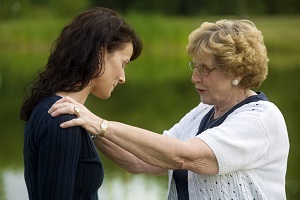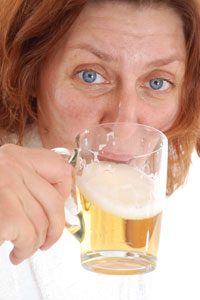Whenever groups of people get together—at work, in families, at the firehouse, on a sports team, or among the club members—individuals take on roles as part of interacting with each other. Someone might be the “class clown” in the room, always quick to make a joke or lighten up a situation; someone else might take on the role of “mom” and do the caretaking for the group. Roles are normal, inevitable, and in healthy situations, they help make for smooth functioning (or an easy target for gentle teasing!).
In families affected by addiction, or any family in which one or both of the parents are unable to fulfill their role as parent, there is a tendency for all family members to take on rigid and surprisingly predictable roles. In any group of children of addicts or alcoholics, ask about the roles in their families growing up and you will hear some very similar reports over and over again. In a dysfunctional family, the key difference regarding roles is that they are rigid: once you’re pegged as a Mascot or Hero, for example, you’re stuck. Behave in a way that is not in line with that role, and your entire family pressures you to get back in line. Placing a value on change, flexibility and authenticity (think of being authentic as embodying and expressing your individuality instead your role behaviors) are not typically part of dysfunctional family dynamics.
Several experts on addiction and family roles have named and described these typical roles. The names are a little different depending upon which author you’re reading: family systems therapist Virginia Satir used the terms placater, adjuster, distracter, blamer, and computer to label the different communication styles and roles family members take on. Claudia Black and Sharon Wegscheider Cruse built upon Satir’s work on communication styles and family roles, and used the names scapegoat, family mascot, hero/responsible one, and lost child to describe the different roles.
In an earlier article we discussed the role of the Chief Enabler, typically a role taken on by the addict or alcoholic’s partner. Here we’ll take a closer look at The Family Hero. This role could be taken on by any child in the family although birth order does seem to play a role with family heroes most commonly being the oldest child. The Family Hero is the child who lives the denial, devoting his or her life to proving that they are fine despite the “elephant in the living room.”
Characteristics of The Family Hero
The Family Hero is the perfect child. He or she takes on being perfect for the family as a way of proving that the addict or alcoholic’s drinking isn’t a problem. Look: I can get good grades, play a sport, and totally have my life together despite Mom or Dad’s drinking. The Family Hero crafts life to contradict the assumption by others outside the family that the drinking or drugging will affect the kids.
The children who take on the family hero role often do extremely well at whatever they take on, and are successful in the eyes of the world. They often become professionals; doctors or other healing professions are common. They often manage money well, and have very high standards for themselves and their own families.
They are often intolerant of their own emotions, and this is their Achilles heel. They need to be perfect, and they need their lives to be perfect to “undo” the imperfections they had to tolerate from early on. The problem is life is not perfect and uncontrollable things happen: accidents, being victimized, relationship problems, health issues…life tosses obstacles in our path constantly and the need to handle each one “perfectly” is a pressure family heroes place upon themselves.
Risks and Pitfalls
 This places the Family Hero at high risk for developing substance abuse problems themselves. Finding a way to cope with the tremendous internal pressures isn’t easy and all those unmet needs from childhood can crash into the adult pressures to “have it all together.” Substance abuse isn’t the only risk: eating disorders are also common among women who have filled this role in a dysfunctional family. The efforts to control the uncontrollable can easily be channeled into controlling eating and weight, and focusing on something tangible: appearance and/or weight can make the overwhelming pressures of making “everything” perfect feel more manageable. Children who have taken on the Family Hero role also seem prone to depression and anxiety, as they try so hard to make everything better than it was during their own childhood but inevitably feel as if they have failed, either due to their own dissatisfactions and old wounds, or due to the challenges and “bumps in the road” that life hands them.
This places the Family Hero at high risk for developing substance abuse problems themselves. Finding a way to cope with the tremendous internal pressures isn’t easy and all those unmet needs from childhood can crash into the adult pressures to “have it all together.” Substance abuse isn’t the only risk: eating disorders are also common among women who have filled this role in a dysfunctional family. The efforts to control the uncontrollable can easily be channeled into controlling eating and weight, and focusing on something tangible: appearance and/or weight can make the overwhelming pressures of making “everything” perfect feel more manageable. Children who have taken on the Family Hero role also seem prone to depression and anxiety, as they try so hard to make everything better than it was during their own childhood but inevitably feel as if they have failed, either due to their own dissatisfactions and old wounds, or due to the challenges and “bumps in the road” that life hands them.
How to Help
Often as an adult, the Family Hero feels like he or she needs to do everything, take on every responsibility, and be in charge of all of it. While this is understandable, since so much didn’t get done in a responsible or timely way during childhood, this inability to delegate or share responsibility, and the need to be in control of everything all the time is draining and destructive. You can see how a Family Hero could grow up to become a Chief Enabler as the roles in adulthood are rather similar.
Psychotherapy aimed at helping shed the Family Hero role can be effective. Learning to tolerate imperfection and the notion of “good enough” (as opposed to perfect) can be life changing for these people.
Part 3: Dysfunctional Family Roles: The Scapegoat Acts Out in Cry for Help
For parents struggling with addictions, trying to manage normal day-to-day family issues such as sibling rivalry and school stresses and pressures is compounded by a special complication, something specific to families dealing with addictions (or families in which one or both parents are unable to function in their parenting role on a regular basis). As hard as most parents try to protect their children from the negative impact of their drinking or drug use, the impact is experienced by all family members. One way this plays out is through rigid and dysfunctional family roles.
(or families in which one or both parents are unable to function in their parenting role on a regular basis). As hard as most parents try to protect their children from the negative impact of their drinking or drug use, the impact is experienced by all family members. One way this plays out is through rigid and dysfunctional family roles.
Before we continue, let me say something about family dysfunction. As a treatment provider for people with addictions and their families for many years, I saw how devastating addictions can be to lives young and old. What’s important to remember here is that despite having an addiction that often leads to very negative behaviors—including violence, abuse, neglect—and despite being labeled “dysfunctional” (we’ll get to that in a moment), these are families that also are bonded by love and loyalty. These are parents who love their children and want the best for them and children who love and defend their parents despite having suffered due to their behaviors.
Taking apart the word “dysfunctional,” the prefix ‘dys’ refers to pain. Dyspepsia is a stomachache; dysmenorrhea is the technical term for painful periods. Dysfunction in the family context means that a family is functioning in pain. Meals do get made, children attend school, play sports, parents work, but the context in which all this happens is emotionally painful. Sometimes my clients would get defensive about the term “dysfunctional,” telling me that it felt like blame to say their family “ didn’t function.” So I make a point of agreeing: there is functioning and often children from families impacted by addiction function very well in some ways; but it would also be unfair and inaccurate to fail to acknowledge the pain that occurs too.
Family Roles
In all families, affected by addiction or not, family members take on roles. Sometimes Mom takes on the role of the discipliner, sometimes Mom is the “banker” for the family. Dad might have been the “sports guy” or the social planner. Imagine a particular behavior—for example, climbing a tree or catching a frog—and most people would then be able to predict which family member would be most likely to engage in that behavior and which would be least likely. The kid who was “outdoorsy” or a girl who fit the “tomboy” role would be first in line. In healthy families, the roles arise from internal personality characteristics and are flexible—as a child grows, develops, and changes, so do the roles.
In families affected by addiction, certain specific roles seem to evolve. These roles are more rigid and predictable, and have been described by a few well-known writers in the field of addiction and family roles. The names change from writer to writer, but the basic roles are similar.
The Second in Command:
In families where addiction is impacting the dynamics, the alcoholics or addicts often have someone on “their side,” someone who takes on the task of keeping the family functioning by keeping the person who is using as functional as possible. This person calls in sick for the drinker, or makes excuses at “Meet the Teachers Night.” They find themselves lying to the kids, the neighbors, their friends and ultimately themselves. Family systems therapists refer to this role as the Chief Enabler, or Codependent. Sometimes in the literature on addiction and alcoholism, people refer to the codependent person as “addicted to the addict.” These people seem to need the relationship more than they seem to need their own health. Let’s take a closer look at this role.
This role is a tough one: the job includes handling all the chores and responsibilities the drinker is not doing. The Chief Enabler just takes over, managing, organizing, acting as the Executive Director, administrative assistant, communications director, and database manager, over-functioning in all these roles (the school principal called? Your boss called? A run-in with police? “I’ll handle it” is the typical Chief Enabler response). He or she is the glue that holds the family together, usually working long hours; often at a job earning money and then at home taking care of all the details that can get left unmanaged when an addict uses.
The purpose of this role is to prevent the family (including the drinker) from experiencing the negative consequences of addiction. Of course this is impossible, which makes this person feel hopeless and frustrated, but also very important, since there are small successes and triumphs (such as a little league game attended by the addict or alcoholic, or open house at the school) along the way. The Chief Enabler feels “stuck” and often very angry about their stuckness because they know how important they are to the “success” of the family (in fact, it often feels like “if I don’t do it, it won’t get done”).
People in this role often receive much praise and support from the community. People outside the family often admire the Chief Enabler, which is one of the few positives about being in this role—often others outside the family recognize how critical the Chief Enablers actions are to the health or even survival of the family—so you hear comments like, “Mary really holds that family together.” The other side of this coin is that they also feel alone and furious at being stuck with being the responsible one who has to take care of everything. The fact that these people often do an excellent job, partly because they’ve had so much practice, is their blessing and their curse and is the catch 22 they experience as “stuckness.”
Read Part 2: Dysfunctional Family Roles: The Family Hero Tries to Hide the Obvious Here.
If you knew something was a risk for cancer would you avoid it? Known carcinogens are usually highly publicized and people frequently adjust their behavior accordingly. One thinks of red dye #2 that was once added to bacon. Sun block sales suggest that many take the risk of skin cancer from sun exposure seriously. And the current intolerance for tobacco use is at least partly driven by the public’s knowledge that smoking causes cancer. Yet, how many are aware that alcohol is also a dangerous carcinogen?

Alcohol is a clear cancer risk, but it gets little public attention as such. According to the World Health Organization, alcohol is responsible for 4 percent of the world’s cancers and is the third greatest risk for developing a host of other serious diseases as well. In the United States, a study published in mid-February in the American Journal of Public Health, states that alcohol is responsible for approximately 20,000 cancer deaths each year–equivalent to about 3.5 percent of all U.S. cancer deaths, according to a news release from the Boston University Medical Center. That translates to 20,000 cancer deaths connected to alcohol consumption. Certainly, alcohol as a cancer risk deserves a bit more press.
In the first major analysis of alcohol and cancer in recent decades, the study looked at 220,000 U.S. adults and examined their alcohol use and mortality information. The researchers found that seven cancers appeared to be particularly linked to alcohol use. Those cancers were: rectal, colon, liver, esophageal, breast (female), pharynx, larynx and oral cancer.
As many as 15 percent of women’s breast cancers were connected to drinking alcohol, a finding which is backed up by the Journal of the American Medical Association (JAMA). This is probably because alcohol affects estrogen levels. In men, cancers linked to alcohol use were oral, larynx, pharynx and esophageal. The data showed that men and women who consumed three or more drinks each day increased their cancer risk by 48 to 60 percent. One-third of cancer deaths were linked to just one to two drinks per day.
The leading risks for cancer are a person’s weight, diet, activity level, tobacco and alcohol consumption. While some have touted drinking certain kinds of alcohol as beneficial to heart health, the facts show that alcohol leads to 10 times more fatalities than it prevents. In fact, those who contract cancer related to alcohol use lose an average of 18 years from their lives.
“The relationship between alcohol and cancer is strong, but is not widely appreciated by the public and remains under-emphasized even by physicians,” said Timothy Naimi, who served as the paper’s senior author. “Alcohol is a big preventable cancer risk factor that has been hiding in plain sight.”
20 Mar 2013
How You Can Support Someone With an Addiction
If you’ve had it up to here with nightly bouts of drunkenness from your spouse or loved one, or you have a good friend who is trying to quit but having a difficult time, you know that the road ahead isn’t an easy one. You may want to support someone who is genuinely interested in getting clean and sober, but may not quite know how to go about it.
Read More
06 Mar 2013
Alcoholism’s Effects in Women
Alcoholism is the classic term for patterns of alcohol abuse that result from a chemical dependence on alcohol’s presence in the body. Along with other abusive patterns of alcohol use, it belongs to a group of conditions known as alcohol use disorders (AUDs). Both men and women can develop a number of serious short- and long-term health complications as a consequence of alcoholism. However, while men become alcoholics more frequently than women, women alcoholics have higher risks than men for developing certain alcoholism-related health problems. In addition, female alcoholics die prematurely much more frequently than male alcoholics.
 The Basics
The Basics
For any given level of intake, women have a greater sensitivity to alcohol’s effects than men. Three physical factors help explain this phenomenon. First, relative to overall size and weight, women’s bodies contain less water than men’s bodies. This is relevant because water dilutes alcohol; therefore, in an environment that contains relatively little water, alcohol remain relatively undiluted and produces intensified effects. Second, compared to men’s bodies, women’s bodies apparently have less active forms of an enzyme called alcohol dehydrogenase, which plays a key role in breaking alcohol down and rendering it harmless; in real-world terms, reduced alcohol dehydrogenase activity translates into higher levels of alcohol lingering in the bloodstream. In addition, some women may be more susceptible to alcohol’s effects during certain phases of their menstrual cycles.
Because of their relative susceptibility to alcohol’s effects, women have a lower recommended maximum daily/weekly alcohol intake than men, the National Institute on Alcohol Abuse and Alcoholism explains. On any given day, the average woman can safely drink as much as a single drink of beer, wine, or hard liquor (the specific size of a standard drink varies according to the type of alcohol under consideration). In any given week, the average woman can safely consume as many as seven total drinks. By comparison, the average man under the age of 65 can safely consume two drinks a day and 14 drinks per week. For a variety of reasons not directly related to alcoholism, men over the age of 65 need to follow the same alcohol consumption guidelines as women.
The Consequences of Alcoholism
As indicated previously, women abuse alcohol and/or develop alcoholism less frequently than men. In fact, women account for only roughly one-third of all of the alcoholics in the United States. However, female alcoholics sometimes experience more severely negative health outcomes than male alcoholics. For instance, according to the Centers for Disease Control and Prevention, alcoholic women have higher chances of developing cirrhosis (scarring of the liver) and other alcohol-related liver disorders than their male counterparts. Compared to alcoholic men, alcoholic women also have higher risks for the onset of damage in the tissues that form the heart muscle; these heightened risks extend to women who abuse alcohol but don’t have all of the hallmarks of alcoholism. In addition, current research suggests that women alcoholics have relatively high chances of developing alcohol-related memory problems and physical shrinkage of their overall brain size. Women also apparently develop these problems more quickly than men.
In comparison to other women, women alcoholics have relatively high chances of developing certain forms of cancer, including cancers of the breast, colon, throat, liver, mouth, and esophagus. In the case of breast cancer, alcoholic women’s risks go up as their rate of alcohol consumption increases. Apart from disease-related risks, alcoholic women have increased risks for exposure to rape and other forms of sexual assault. These assault-related risks extend to women who participate in a form of alcohol abuse called binge drinking, which involves consuming enough alcohol within a two-hour timeframe to become legally intoxicated; most women reach a legally intoxicated state (marked by a blood alcohol content equal to or in excess of 0.08 percent) when they consume four or more drinks within this span of time.
Fatal Consequences
When considered together, men and women alcoholics between the ages of 18 and 64 die an average of 20 years sooner than people without alcohol dependencies, according to the result of a 14-year study published in published in 2012 in the journal Alcoholism: Clinical & Experimental Research. However, when the two genders are considered separately, women alcoholics in this age range die twice as often as alcoholic men. Compared to the general population, alcoholic women between the ages of 18 and 64 die more than four times as frequently. The authors of the study note that their results may somewhat overestimate women alcoholics’ risks for fatal outcomes, but believe any overestimation (if it exists) is in terms of specific percentages rather than the basic results of their research.
Alcohol withdrawal is a condition that occurs when a long-term, heavy drinker stops using alcohol. It inevitably appears in alcoholics who decide to stop drinking and seek alcohol addiction treatment. Depending on factors that include the length of alcohol use and the intensity of alcohol use, the symptoms of withdrawal can range from relatively mild to severe or even life-threatening. Unfortunately, fear of these symptoms can play a significant role in continued drinking and the avoidance of treatment. However, in the vast majority of cases, alcohol withdrawal produces more or less predictable changes in the body, and proper monitoring and medical treatment can help a recovering drinker make it through this process.
Read More
Expectant mothers are recommended to completely avoid alcohol during pregnancy. While new information is regularly gained by ongoing research, it has long been understood that alcohol certainly provides no benefit to the fetus. Instead, the use of alcohol during pregnancy has been linked to major cognitive and physical development problems.
Read More
Many studies on alcoholism have focused on how the symptoms of the disease hurt the individual and their family. Alcoholism can spur verbal and physical abuse. It can cause liver damage, impair the brain, and interfere with multiple other disorders of the body. Treatment can help alleviate these symptoms and rebuild better bodies, minds, and family/friend relationships. Few studies though have examined how alcoholism can hurt the pocketbook and how treatment can help families recover from the financial strain that alcoholism has placed on them.


